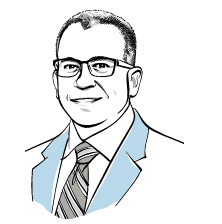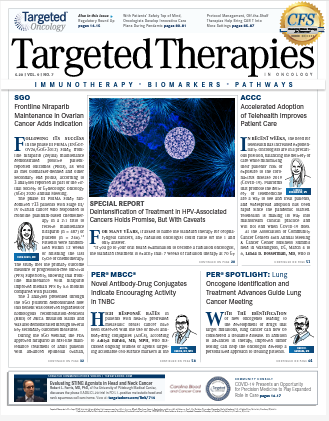Protocol Management, Off-the-Shelf Therapies Help Bring CAR T Into More Settings
Relevant professional meetings and oncology publications exploded with research and news about chimeric antigen receptor T cells, and this cellular therapy strategy is now being explored across hematologic and solid malignancies.
Carlos R. Bachier, MD

Chimeric antigen receptor (CAR) T-cell therapies quickly burst into the spotlight of hematology-oncology disease management because of their potential to illicit deep and durable responses from patients whose disease is relapsed or refractory to multiple previous lines of therapy. Relevant professional meetings and oncology publications exploded with research and news about CAR T cells, and this cellular therapy strategy is now being explored across hematologic and solid malignancies.
“CAR T cells are a scientific revolution,” Tania Jain, MBBS, assistant professor of oncology at Johns Hopkins University in Baltimore, Maryland, said in an interview with Targeted Therapies in Oncology (TTO). “They have brought about a paradigm shift in terms of how we’re treating patients.”
The 2 currently FDA-approved CAR T-cell therapies, axicabtagene ciloleucel (Yescarta) and tisagenlecleucel (Kymriah), are both indicated for the treatment of adult patients with relapsed or refractory large B-cell lymphoma; additionally, tisagenlecleucel is approved for patients up to 25 years with relapsed or refractory B-cell precursor acute lymphoblastic leukemia (ALL).1-3 With a second wave of approvals likely on the horizon for therapies such as lisocabtagene maraleucel (liso-cel) and idecabtagene vicleucel (bb2121), CAR T is gaining traction and will likely play an increasingly prominent role in the future treatment paradigm in oncology.
CAR T-cell therapy administration is largely limited to the inpatient setting at both academic institutions and large accredited cancer centers, making such treatments unavailable to most patients. Other challenges with this type of therapy include its potential to cause serious toxicities resulting in organ damage and death.4
David G. Maloney, MD, PhD

Due to the promising efficacy of these agents, investigators have been working toward viable solutions to bring CAR T-cell therapies to more patients by alleviating difficulties associated with therapy delivery and patient care.
Barriers to Manufacturing CAR T Cells Are Addressed
CAR T-cell therapies, both those currently approved and the many being explored in late-phase clinical trials, are produced from autologous T cells obtained from the patient receiving therapy. This personalization has led to tremendous success, yet it is a large part of why CAR T-cell therapy use remains limited to a select group of patients.
Time is an important consideration for patients who have experienced multiple relapses and may be too weakened by numerous lines of prior therapy to wait several weeks for the CAR T-cell manufacturing process. The effects of previous treatments or the disease itself can also present challenges, as manypatients are rendered lymphopenic and may be unable to produce enough T cells for harvesting. Roadblocks may remain for patients who are not limited by these factors; manufacturing success and effectiveness of the CAR T-cell product can be negatively influenced by disease-related dysfunctions of patients’ T cells.4
A new option, off-the-shelf CAR T-cell products, may help solve these problems. These premade products are manufactured using allogeneic donor cells (instead of autologous cells from the patient), and they present immediate advantages to clinicians, such as immediate availability, opportunity for product standardization, and decreased cost.5
“The advantages [include] being able to access the cellular therapy in real time, as opposed to autologous products that havetobe manufactured,”Craig S. Sauter, MD, clinical director of the Adult Bone Marrow Transplant Service at Memorial Sloan Kettering Cancer Center in New York, New York, explained in an interview withTTO. This is particularly important for patients who are not responding to therapy, which is a current requirement for treatment with CAR T cells, he added.
Findings from a phase I trial (NCT01430390) in patients with relapsed or refractory B-cell malignancies showed that patients with non-Hodgkin lymphoma (NHL) experienced durable responses with an Epstein-Barr virus–specific cytotoxic lymphocyte CAR product derived from cells harvested from third-party donors (rather than from their more precisely matched stem cell donors). All 4 patients with NHL and a single patient with chronic lymphocytic leukemia, who were treated with third-party cells, remained disease free and alive at the time of analysis, with a median follow-up of over 2 years.6
“The advantages [of this type of therapy are] that it eliminates the need for apheresis [and] shipping cellular products back and forth. [Instead, clinicians] have a pharmaceutical product on the shelf for access,” Sauter, who was an author on the trial, said. Another notable product being investigated in clinical trials is UCART19, an allogeneic engineered anti CD19CAR T-cell product, which is being evaluated in the phase I CALM trial in adult patients with relapsed or refractory B-cell ALL (NCT02746952) and in the phase I PALL trial of pediatric patients with relapsed or refractory CD19-positive B-cell ALL (NCT02808442). Other off-the-shelf agents are described in theTABLE.5
Optimizing Adverse Event Management for the Outpatient Setting
Issues with inpatient CAR T-cell therapy administrationinclude high demands on health care resources and strain on patients and their families. Moving treatment to the outpatient setting has the potential to reduce this strain; however,clinicians taking over care of patients receiving CAR T-cell therapy must be prepared with the proper resources to identify and manage adverse events associated with therapy.
One of the most notable risks to patients receiving CAR T-cell therapy is cytokine release syndrome (CRS), a systemic inflammatory response that is characterized by increased serum levels of inflammatory cytokines, fever, hypotension, hypoxia, and organ dysfunction.4 “[CAR T] can also lead to neurological events and can cause confusion and, in some patients, seizures,”Carlos R. Bachier, MD, Director of Cellular Research at Sarah Cannon Cancer Center in Nashville, Tennessee, explained in an interview with TTO.
Regardless of the infusion setting, patients require close monitoring in the hours and days following therapy administration. A review byLucrecia Yáñez, PhD, MS, and colleagues stated that key criteria for treating patients in the outpatient setting include an educated caregiver and necessary infrastructure allowing for outpatient visits plus adequate emergency and intensive care unit (ICU) access. Patients followed as outpatients must be given twice-daily temperature checks for a minimum of 14 days following treatment and preferably extending up to 3 to 4 weeks following infusion. Anysigns of back pain, skin rash, dizziness, chills, shortness of breath, chest pain, tachycardia, or neurological events that may indicate neurotoxicity or signs of CRS must be reported immediately so treatment can begin as quickly as possible.7
Because of the risk of CRS and neurotoxicity, both FDA-approved agents are restricted under the Risk Evaluation and Mitigation Strategy, an FDA-mandated program that builds in caution for use of agents with serious safety concerns.8,9 Therefore, 2 doses of tocilizumab (Actemra), an interleukin (IL)-6 receptor antagonistthat was approved in 2017 for management of CRS associated with CAR T-cell therapy,1,4 should be on hand for each patient before the infusion of CAR T cells. Steroids have also demonstrated efficacy against CRS, but concernssurrounding CAR T-cell suppression with these agents have established them as a second-line choice after tociluzumab.9
Immune effector cell–associated neurotoxicity syndrome (ICANS) is a group of neurologic symptoms associated with treatments such as CAR T-cell therapy. Predisposing factors include younger age, higher tumor burden, high levels of pretreatment inflammation, and history of early or high-grade CRS. Treatments for complications of ICANS vary. Some centers may prescribe prophylactic antiepileptic medications, such as levetiracetam, to prevent seizures in patients with grade 2 or higher neurologic events. Anti–IL-6 therapy can be considered in patients with concurrent CRS, but corticosteroids are the preferred regimen in those with neurotoxicity alone.9
Moving Liso-Cel to the Outpatient Setting
In February of this year, the investigational CAR T-cell product liso-cel was granted priority review by the FDA for the treatment of adult patients with relapsed or refractory large B-cell lymphoma who had undergone at least 2 prior therapies.10 Investigators believe that liso-cel therapy may have a place in a broad range of patients and in the outpatient setting.11
“It turns out liso-cel has a low incidence of [CRS and ICANS], and they occurred relatively late compared with other products,” said Bachier. “Because of this low incidence, the strategy was to deliver liso-cel in an outpatient setting.”
The feasibility of liso-cel administration on an outpatient basiswas evaluatedby Bachier and colleagues, and the results were presented at the 2020 Transplantation & Cellular Therapy Meetings of the American Society for Transplantation and Cellular Therapy and the Center for International Blood & Marrow Transplant Research, held February 19 to 23, 2020, in Orlando, Florida.12
The authors analyzed data from 3 clinical trials of liso-cel, with a focus on the subset of participants who were treated as outpatients. The included trials were the phase I TRANSCEND-NHL-001 (NCT02631044) and phase II OUTREACH (NCT03744676) trials in patientswhohadundergone at least 2 lines of prior treatment, as well as the PILOT study (NCT03483103), which examined liso-cel as second-line therapy in patients who were ineligible for autologous hematopoietic stem cell transplant because of age, organ function, or ECOG performance score. All 3 studies allowed outpatienttreatment, with some patients receiving their therapy in the nonuniversity setting.
“This clinical trial included sites that were not a part of a university but had experience treating patients for stem cell transplant,” Bachier said. “Some of these sites that participated were notyour traditional university centers that had traditionally been involved in the development of these therapies.”
Much caution was required in order to maximize patient safety and treatment efficacy. “The approach of doing CAR T-cell therapy, in general, in the outpatient setting requires a robust clinical ability of the centers,” said coauthor David G. Maloney, MD, PhD, medical director of Cellular Immunotherapy at the Immunotherapy Integrated Research Center of Fred Hutchinson Cancer Research Center in Seattle, Washington, in an interview. “We were able to get people safely to the hospital, and it was rare that you would have to do escalation of care when people were admitted. Most of the time, patients could bemanaged…and wereout of the ICU, withrare exceptions. But again, you still have to have the wherewithal to get patients to the ICU pot entially for aggressive care if needed.”
Results of the analysis of outpatient data from the 3 trials showed that rates of toxicity and response were similar to those previously reported for the entire patient cohort (both inpatients and outpatients) of the TRANSCEND-NHL-001 trial.
“Based on these results, the indication is that you can deliver [liso-cel] in the outpatient setting and the outcomes are good compared with those treated in the inpatient setting,” said Bachier. “Aside from that, it also showed that liso-cel could be safely administered outside of university programs and in more community-based programs, most of them being aligned [with] or part of stem cell and bone marrow transplant programs.”
Next Steps for Bringing CAR T Into More Clinical Settings
When planning or setting up a CAR T-cell therapy outpatient program, investigators anticipate possible barriers to successfultreatment. The greatest barrier, according to Bachier, is access to physicians and staff who are knowledgeable and trained to manage toxicities related to CAR T-cell therapy. “These therapies still should not, in my opinion, be delivered [by clinicians in] community centers that do not have the expertise to deliver the therapies safely,” he said.
Maloney added that centers should be required to have the ability to triage patients 24/7 and allow for patients to be directly admitted to the hospital if needed. In the case of the analysis of outpatient data from the 3 liso-cel trials however, he said, “We found that around 30% to 40% of patients did not actually ever require hospitalization, whichis quite interesting.” Most of the 60% to 70% of patients who were hospitalized were admitted for fever, he added.
In addition, sites must gain accreditation and approval, Jain pointed out.
“Every center that intends to do CAR T-cell therapy is first approved by each of the companies [that manufacturethese agents],” Jain said. “The centers also have to be approved by FACT [Foundation for the Accreditation of Cellular Therapy], which is the same organization that approves centers for allogeneic stem cell transplant. These are some of the largest things that a center needs to go through, which takes care of things like developing standard practices and other guidelines to make sure that these [therapies] are used safely and appropriately.”
Forward-Looking Aspects of Cellular Therapy
As investigators and oncologists explore the feasibility of moving CAR T-cell therapy into more settings, 2 questions arise: What settings have on this therapy?
What type of training and skills do clinicians need? Like other clinicians, Sauter has concerns about new allogeneic cellular therapies,andhe hopes future research will focus on mitigating these challenges. “The concern would be that these are not autologous products and there is the risk of rejection from the host immune system,” he said. “Strategies to circumnavigate that risk are at the forefront of investigationin off-the-shelf CAR T cells.”
The research is not stopping with CAR T-cell therapy,though. “We’re seeing a lot of new molecules coming in that will be challenging the roles of CAR T cells, [such as] specific antibodies, which may even work in cases of CAR T-cell failure,” Maloney said. “We are still learning how to make those more effective and safer.”
References:
1. FDA approves tisagenlecleucel for B-cell ALL and tocilizumab for cytokine releasesyndrome.FDAwebsite.PublishedAugust30,2017.AccessedApril14, 2020. bit.ly/2RC4eQ8
2. FDA approves axicabtagene ciloleucel for large B-cell lymphoma. FDA website. Published October 18, 2017. Accessed April 14, 2020. bit.ly/2yYIQOp
3. FDA approves tisagenlecleucel for adults with relapsed or refractory large B-cell lymphoma. FDA website. Published May 1, 2018. Accessed April 14, 2020. bit.ly/34zPoi8
4. Rafiq S, Hackett CS, Brentjens RJ. Engineering strategies to overcome the current roadblocks in CAR T cell therapy. Nat Rev Clin Oncol. 2020;17(3):147167. doi: 10.1038/s41571-019-0297-y
5. DepilS,DuchateauP,GruppSA,MuftiG,PoirotL.‘Off-the-shelf’allogeneic CAR T cells: development and challenges. Nat Rev Drug Discov. 2020;19(3):185199. doi: 10.1038/s41573-019-0051-2
6. Curran KJ, Sauter CS, Kernan CS, et al. Durable remission following “off-theshelf” chimeric antigen receptor (CAR) T-cells in patients with relapse/refractory (R/R) B-cell malignancies. Presented at: 2020 Transplantation & Cellular Therapy Meetings; February 19-23, 2020; Orlando, FL. Abstract 120. bit.ly/2ufDYCu
7. Yáñez L, Sánchez-Escamilla M, Perales MA. CAR T cell toxicity: current managementandfuturedirections. Hemasphere.2019;3(2):e186.doi:10.1097/ HS9.0000000000000186
8. Risk evaluation and mitigation strategies | REMS. FDA website. Updated August 8, 2019. Accessed April 14, 2020. bit.ly/2ykhLVt
9. JainT,BarM,KansagraAJ,etal.UseofchimericantigenreceptorTcell therapy in clinical practice for relapsed/refractory aggressive B cell non-Hodgkin lymphoma: an expert panel opinion from the American Society for Transplantation and Cellular Therapy. Biol Blood Marrow Transplant. 2019;25(12):2305-2321. doi: 10.1016/j.bbmt.2019.08.015
10. U.S. Food and Drug Administration (FDA) accepts for Priority Review Bristol-Myers Squibb’s Biologics License Application (BLA) for lisocabtagene maraleucel (liso-cel) for adult patients with relapsed or refractory large B-cell lymphoma. News release. Bristol-Myers Squibb; February 12, 2020. Accessed April 15, 2020. bit.ly/37ruQbs
11. Helwick C. Strong activity shown for lisocabtagene maraleucel CAR T-cell therapy in aggressive large B-cell lymphoma. ASCO Post website. Published February 25, 2020. Accessed April 15, 2020. bit.ly/3eoD0pT
12. Bachier CR, Palomba ML, Abramson JA, et al. Outpatient treatment with lisocabtagene maraleucel (liso-cel) in 3 ongoing clinical studies in relapsed/refractory (R/R) large B cell non-Hodgkin lymphoma (NHL), including second-line transplant noneligible (TNE) patients: TRANSCEND NHL 001, OUTREACH, and PILOT. Presented at: 2020 Transplantation & Cellular Therapy Meetings; February 19-23, Orlando, FL. Abstract 29. bit.ly/37I7DC9

Survivorship Care Promotes Evidence-Based Approaches for Quality of Life and Beyond
March 21st 2025Frank J. Penedo, PhD, explains the challenges of survivorship care for patients with cancer and how he implements programs to support patients’ emotional, physical, and practical needs.
Read More